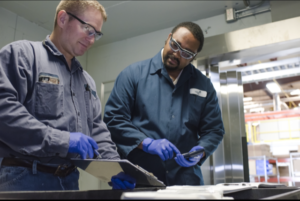Corporate Responsibility
Precious metals: Catalyzing industrial innovations 25th November 2020
By Volker Raab, PhD, Director Global Segment Homogeneous Catalysis, Umicore Precious Metals Chemistry
The chemical industry is continuing to develop green chemical processes in response to customer and consumer demand and the precious metal catalysts sector is no exception to this. Dr Volker Raab of Umicore PMC explains how key industry stakeholders are responding to such demand and gaining new insights into how both existing and developmental precious metal catalytic processes may be improved.
Over the past few decades, the chemical industry has expanded its primary focus from product innovation to ensuring sustainable product and process development. As stakeholders begin to realize the benefits of green and environmentally friendly chemical processes, the industry is demanding innovative catalytic technologies that offer improved yields, high selectivity and lower energy requirements. When addressing sustainability, modern chemists are faced with many new and evolving challenges. Smarter and greener catalytic technologies can provide the chemical and pharmaceutical industries with the cutting-edge tools needed to overcome these difficulties.
By examining how key stakeholders in these industries are approaching catalytic process development, it is possible to gain insights into the challenges and key solutions that can be used to further their improvement.
Recognizing challenges
When looking to improve industrial processes, it is important to first examine how these methods are developed. Having been taught a whole host of traditional reactions, such as the Wittig or Horner-Wadsworth-Emmons (HWE) reactions, process chemists and engineers might feel the requirement to stick to the classics. But on further inspection, in many conditions these reactions have poor atom economy and are highly inefficient. For example, the Wittig reaction, which finds multiple industrial uses such as in vitamin and carotenoid synthesis, can produce large amounts of waste, such as triphenylphosphine oxide (TPPO). This issue is further compounded as TPPO is notoriously difficult to separate from desired products.1
While these challenges may not dramatically impact the efficiencies at lab scale, during scale-up these issues may severely affect process performance. As such, it is necessary to take a step back and understand how a process is developed and consider the conditions that the reaction is most likely to be carried out in. Only when these factors are extensively studied will it be possible to begin to develop sustainable, efficient and robust processes.

Process technicians at the Umicore PMC facility in Tulsa, OK, USA. Precious metal catalysis is making its contribution to a cleaner and greener chemical industry.
Optimized chemistries
In many industries within the chemical sector, chemical commodities are passed on within their relevant sector as semi-finished products. As a result, these high-value products often undergo longer and less sustainable processes.
Precious metals have long been used in catalytic systems, often providing rapid and more sustainable routes to high-valued and industrially important compounds. However, some routes that require costly transition metal catalysts can often lose a high percentage of the catalyst during reactions, be it through specific intermediate reactions, or unoptimized metal separation and recycling methods. Hydroformylation, also known as the oxo synthesis, is one of the most important homogeneous catalyst-mediated reactions. It enables highly versatile aldehyde functional groups, which are useful for further manufacturing of performance chemicals and chemical intermediates such as plasticizers, lubricants, etc. The hydroformylation reaction can be catalyzed by a rhodium containing catalyst and its industrial viability relies on the combination of the selectivity of the catalyst together with the high efficiency of its separation – once used – from the reaction stream and of the recycling of the Rh metal it contains. Umicore’s global approach to both high-quality catalyst and highly efficient metal recycling, in this instance, is a key way to protect this precious metal investment. This helps to ensure long-term profitability of a reaction or process, whilst helping to increase its productivity.
Alongside ensuring that chemical or pharmaceutical reaction routes are both cost- and time-efficient, industries need to limit the environmental impact of their processes. Catalysis has long been at the forefront of green chemistry, and is an essential consideration when analyzing new systems and processes. The production of waste, and the use of high temperatures and pressures, are all common problems to overcome in many industries, and are essential considerations when ensuring the circular economy and valorization of feedstocks. One such example, which has been published by researchers in polymer chemistry, used Umicore’s metathesis catalysts to facilitate the previously difficult process of recycling natural rubber (NR).2 The study, by Abbas et al, utilized cross-metathesis to degrade vulcanized rubber waste, promoting its conversion to norbornenes through a cycloaddition reaction. NR production amounts to about 13.3 million tonnes per year, and with incineration being the typical end-of-life treatment, alternatives had become an increasingly important time- and money-saver.3

Production control at the Umicore PMC plant in Tsukuba, Japan. Precious metal catalysis is making its contribution to a cleaner and greener chemical industry.
The tools for success
While metathesis technologies have already been readily applied to a vast majority of sectors, its true value remains to be unharnessed. Metathesis has the potential to provide a sustainable and green approach to reaction synthesis. Being able to shorten complex reaction steps can improve productivity, reduce waste and energy consumption, use less solvent, or even reduce the CO2 emission footprint of a reaction. Related to the sustainability component, metathesis reactions are increasingly being sought as alternatives to previously difficult reactions or processes.
The future possibilities for success are seemingly endless. When specifically looking at the chemical industry, metathesis has already proven to be successful in many manufacturing industries. These include, but are by no means limited to, the manufacture of active molecules for hepatitis C virus (HCV) treatments and the creation of functional polymers with temperature-, corrosion- or abrasion-resistance properties.4,5 In these applications, metathesis has proven a key enabler for efficiency, allowing previously difficult reaction pathways in this area to be reached with relative ease.
Umicore PMC has been active in providing metathesis catalysts for more than a decade, and recognizes that this has not been done alone: collaborations within academia and industry have built the foundations of an unrivalled portfolio of intellectual property and metathesis catalysts that can be applied at an industrial scale. This portfolio, leveraged with multiple decades of expertise in the field, has enabled the continued growth of the range, and helped to establish new and exciting collaborations within both the academic and industrial setting.
Shaping sustainable pathways
There is a growing demand for chemical processes that generate less waste and provide companies with a long-term, green future, all whilst providing commercial benefits. The future of the chemical industry is therefore undoubtedly environmentally friendly, with regulatory requirements forcing cleaner reactions. New synthetic processes are utilizing highly-reactive compounds in low concentrations to increase throughput and push reactions to be both cleaner and cost efficient.
Umicore PMC offers the combination of metathesis catalysts with advanced homogeneous catalysts, including Buchwald catalysts and multiple generations of Grubbs catalysts. Many years of research have ensured that the necessary manufacturing capabilities can be offered, and the advanced catalyst needs of global partners can be met, at their desired scale. And, by further advancing academic and industrial partner collaborations, any reaction bottlenecks can be overcome and the next generation of materials created.
REFERENCES
- Davey, S. Wittig without waste. Nat. Chem. (2009) doi:10.1038/nchem.395.
- Abbas, M., Neubauer, M. & Slugovc, C. Converting natural rubber waste into ring-opening metathesis polymers with oligo-1,4-cis-isoprene sidechains. Polym. Chem.9, 1763–1766 (2018).
- Association of Natural Rubber Producing Countries. Rubber and Plastics News 2018. (2018).
- Tsantrizos, Y. S. et al. Olefin ring-closing metathesis as a powerful tool in drug discovery and development – potent macrocyclic inhibitors of the hepatitis C virus NS3 protease. J. Organomet. Chem. 691, 5163–5171 (2006).
- Sinclair, F., Alkattan, M., Prunet, J. & Shaver, M. P. Olefin cross metathesis and ring-closing metathesis in polymer chemistry. Polym. Chem. 3385–3398 (2017).



